Types of shipping containers (and which one to choose)
In the first part of the three-part miniseries about sea containers, we took a trip down memory lane, talking about the history of shipping containers. In the second part, we will have a look at the most common types of intermodal containers and what they’re used for.
Dry storage containers
These are the most used containers in the world. The most common is a 40ft container, followed by a 20ft container. Both of these are 8ft wide and 8ft 6in tall. They have double-wing doors on one side, and there are holes on the side walls by the upper edges to help with the ventilation.
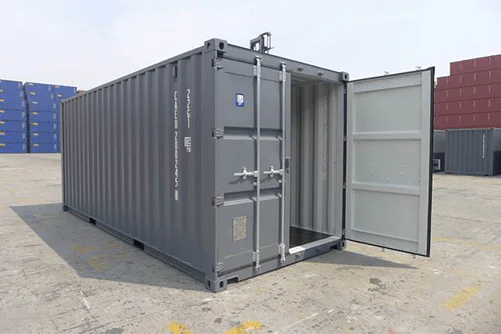
20ft dry storage container
Source: https://containertech.com/articles/use-a-shipping-container-for-dry-storage
High Cube containers
High cube (HC) containers can be either 40 or 45ft long. Exceptionally, we can also encounter 20ft HC containers. The width is the same as for standard 20ft and 40ft containers, which is eight feet. The difference is in height, where HC containers are about one foot higher, reaching 9ft 6in. Same as standard containers, they also have double doors on one side.
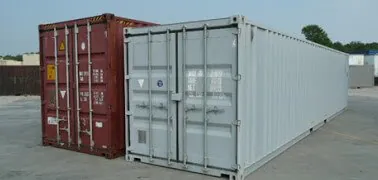
Standard 40ft container (on the right) and 40ft high cube container
Open-top containers
Open top containers are exactly the same as standard 20ft and 40ft containers, with only one difference – the roof, which is most often tarpaulin, can be removed. That’s very convenient if you load bulky, heavy cargo, which needs to be loaded from the top by a crane. Another example is for loading grain, which is usually poured by crane or excavator from the top.
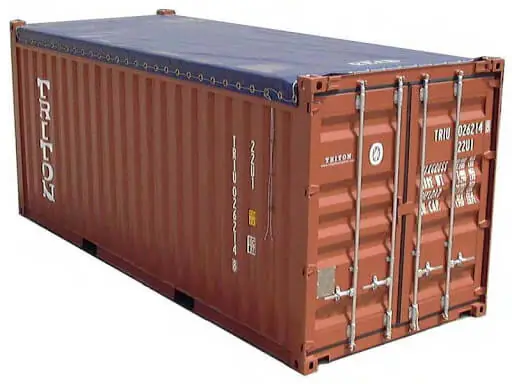
20ft open top container
Source: https://www.universal-containers.com/open-top-containers/
Flat rack containers
Again, flat rack containers are made 20ft and 40ft long. They have two advantages. The first is that the container doesn’t have the left and right sides as well as the top, so that anything can be loaded there easily with a forklift, even very high cargo. The second advantage is that the front and back sides are collapsible inwards, making for a flat surface, so, for example, a truck can be driven onto it. Flat rack containers are used for transporting construction machinery, boats, or even a bus. After collapsing the sides, you can stack up to five on top of each other, which is another advantage when transporting empty flat rack containers.
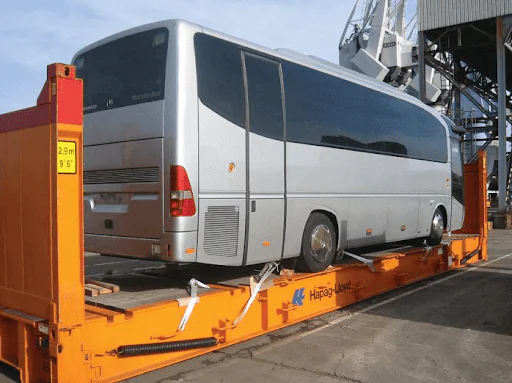
Bus loaded on flat rack container
Car carrier container
Car carrier containers are specifically designed for car transportation. They are divided into two halves with a retractable platform so that you can fit two cars in the container. Often, they also have removable sides for easier manipulation when loading the vehicles.
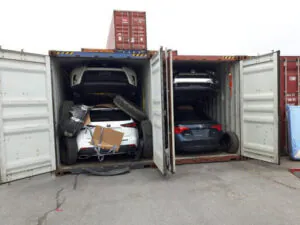
Two loaded car carrier containers
Tunnel container
Also called a double door container, it is the same as a standard 20ft container, but it has doors on both sides. This makes loading and unloading significantly easier. It is usually 20ft long. Since it’s easy to turn any standard container into a tunnel container just by swapping the backside for a wing door, we can also encounter other lengths. Tunnel containers can be divided by a metal partition, resulting in two 10ft containers, each with its own entry.
People found many inventive ways of use for double door containers, including a temporary bridge, a biomass boiler, or a catering festival stand.
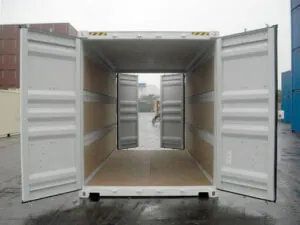
Tunnel container
Source: https://newshippingcontainers.com/wp-content/uploads/2019/08/double-door-3-768×576.jpg
Open-side container
Another type of container used for more effortless loading and unloading is an open side container, whose (usually) one side can be opened. That is good if you need to access specific cargo faster or if it is too big to be loaded through the front door. You can see both 20ft and 40ft open side containers.
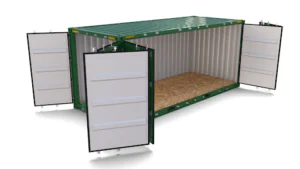
20ft open side container
Source: https://3dexport.com/3dmodel-20ft-shipping-container-side-open-209079.htm
ISO reefer container
ISO reefer containers commonly referred to as reefers, have external power units, enabling the operator to set an exact temperature, usually ranging from -40°C(-40°F) up to +30°C (86°F). That is ideal for transporting perishable goods such as fruits, vegetables, fish, meat, or medicaments. Reefers can come in many sizes, most often being again 20ft and 40ft.
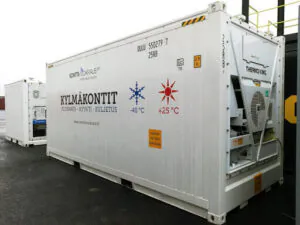
20ft HC ISO reefer container
Tank container
A tank container, also known as a tanktainer, is a cylindrical vessel from stainless steel in the middle of a steel frame with (usually) standard ISO dimensions. They are suitable for the transport of liquid materials, gases, or powder. Tank containers should be generally filled only between 80-95% full to prevent dangerous surging of liquids in transit, as well as to have enough room for gas expansion.
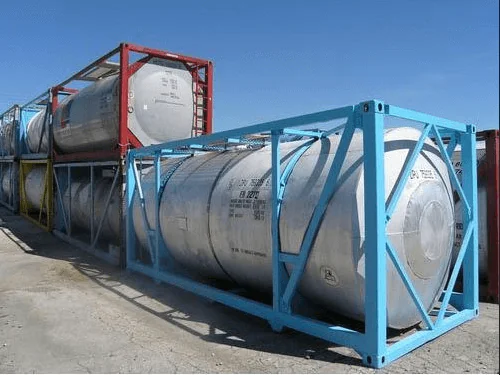
20ft ISO tank container
Source: https://www.indiamart.com/proddetail/iso-tank-container-3599336291.html
These are nine of the most common intermodal containers. Naturally, this list isn’t complete as there are plenty of other container types such as insulated containers, half-height containers, swap bodies, drums, and so on. This being said, if you go to the port and look at a container ship, you’ll recognize most of the containers on its deck from this article.
Don’t know which container size to choose? Not sure if your goods fit into 20ft containers or if you need to order 40ft containers? Import the list of your load items into EasyCargo, select the container, and you will know within a few seconds whether or not it fits. There are 12 most common types of container sizes predefined in EasyCargo, and if you have an unusual one, you can create your own cargo space.




